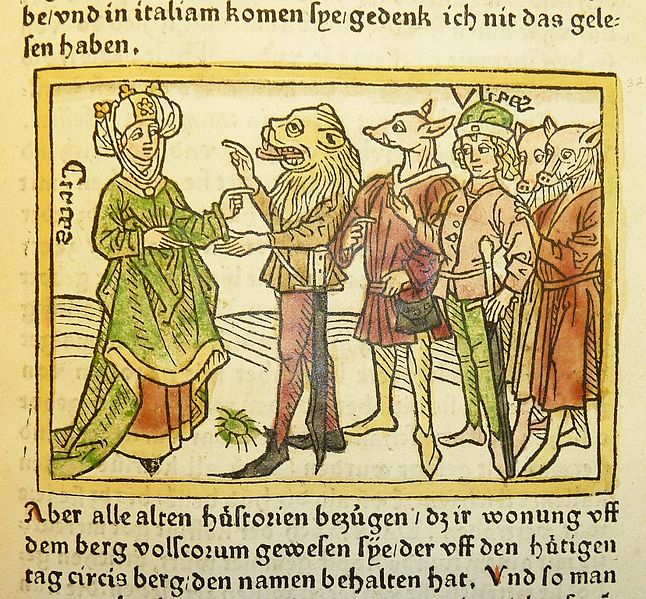One of my favorite story retellings and character vindications is Circe’s story, as told in Madeline Miller’s novel. Circe, according to Greek mythology, was a powerful sorceress and enchantress with extensive knowledge of herbology and potions.She is best known as the enchantress who turned Odysseus’ men into pigs to punish their drunkenness and lack of respect. Circe was also the sole person responsible with helping Odysseus perform the impossible task of navigating the Underworld. Let’s learn more about this incredibly powerful and fascinating sorceress and her life.
Circe Key Facts
| Parents | Helios (Sun God) and Perse (Oceanid nymph) |
| Partners | Odysseus |
| Siblings | Aeetes, Pasiphae, and Perses |
| Offspring | Telegonus |
| Other names | None |
| Roman name | Circe |
| The Goddess of | Magic, transformation |
| Symbols | Wand, loom, wild animals, especially lions and wolves |
Name and Etymology
The name “Circe” is believed to be derived from the Greek word “kirke,” which translates to “falcon.” This might be indicative of her sharp, piercing nature or perhaps a reference to her transformative abilities. In Roman mythology, her name remains unchanged, a testament to her enduring influence across cultures. Throughout various texts, Circe is often referred to by epithets that highlight her skills in witchcraft and her seductive nature.
Circe’s Family and Childhood
Born to the Titan sun god, Helios, and the Oceanid nymph, Perse, Circe’s lineage was nothing short of divine. She was a princess of the sun, with her siblings including the likes of Aeetes, keeper of the Golden Fleece, and Pasiphae, the ill-fated queen of Crete who gave birth to the Minotaur, a half-man, half-bull monster. With such a family, it’s no wonder Circe developed her own unique set of powers and quirks.
Circe’s birth, while not as elaborately documented as some other gods and goddesses, was significant in its own right. As the daughter of the sun, she was born with a natural affinity for magic. This inherent talent was nurtured and honed as she grew, making her one of the most formidable sorceresses in all of Greek mythology.
Her childhood, though shrouded in mystery, was likely spent in the radiant halls of her father, Helios. Given her later expertise in herbs and potions, it’s plausible to assume that her early years were spent studying the ancient arts under the guidance of Nymphs, Guardians of Nature and other deities.
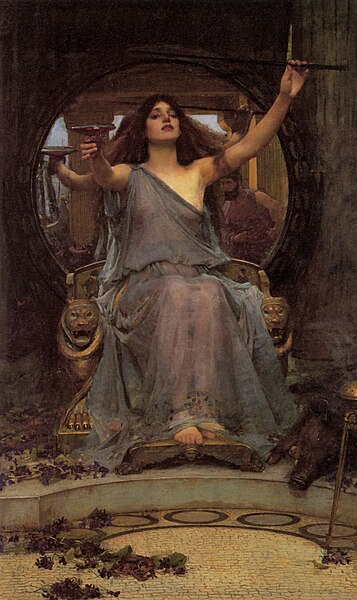
Circe’s Lovers and Relationships
Circe’s love life, much like her existence, was filled with twists and turns. Her relationships were marked by passion, magic, and, at times, treachery.
Odysseus
Perhaps the most famous of Circe’s lovers was the legendary hero, Odysseus. During his ten-year journey back to Ithaca after the Trojan War, Odysseus and his crew landed on Aeaea, Circe’s island. Initially, she turned his men into pigs, but with the help of Hermes, Odysseus resisted her spells. Impressed by his resilience and wit, Circe released his men, and the two became lovers. They spent a year together on her island, with Circe aiding Odysseus in his journey home by providing crucial advice and guidance.
Circe’s Offspring
Circe, while not known for numerous relationships in mythology, had a profound connection with Odysseus, which bore significant consequences for both their destinies. From their union came Telegonus, a child who would inadvertently entwine his fate with the tragic tapestry of the “Odyssey.” This offspring carried with him not just Circe’s magical lineage but also the weight of a destiny that would see him play a pivotal role in the culmination of Odysseus’s epic journey.
Telegonus
Telegonus, Circe’s son with Odysseus, grew up on the island of Aeaea, under the watchful eyes of his mother. Imbued with her magical abilities and raised on tales of his father’s valor, Telegonus harbored a deep desire to meet Odysseus. Circe, foreseeing the tragic fate that awaited them, tried to dissuade him, but the pull of destiny proved too strong.
Setting sail to find his father, Telegonus inadvertently landed on Ithaca. The islanders, unaware of his identity, saw him as a threat. In the ensuing skirmish, Telegonus, using a spear tipped with the venomous spine of a stingray (a gift from his mother), accidentally killed Odysseus, not realizing the fallen warrior was his father. The tragedy of a son unknowingly causing the death of his father adds a layer of profound sorrow to the overarching narrative of the “Odyssey.”
Upon realizing the gravity of his actions, Telegonus was consumed with remorse. He returned to Aeaea, bringing with him the body of Odysseus and his half-brother, Telemachus. Circe, using her powers, tried to alleviate their pain. She made Telegonus, Telemachus, and Penelope, Odysseus’s wife, immortal. The island of Aeaea then became their eternal abode.
Other Offspring
While Telegonus remains the most prominent of Circe’s children, there are mentions in various texts of other offspring. Some sources suggest that Circe had two other sons with Odysseus named Agrius and Latinus. Latinus is sometimes identified as the legendary ruler of the Latins in Italy. Another child, often associated with Circe, is Cassiphone, though her role and narrative are less defined in the myths.
Depiction and Characteristics
Circe, often portrayed as a regal, ethereal figure, exudes an aura of both allure and danger. With flowing robes and a staff or wand in hand, she embodies the essence of a sorceress, commanding both respect and caution.
Circe’s Appearance
Circe’s beauty is frequently commented upon in ancient texts. With long, flowing hair and eyes that seem to pierce the soul, she’s the epitome of a bewitching enchantress. Often, she’s depicted surrounded by animals, a nod to her transformative powers and her dominion over the beasts of her island. Her attire, usually a flowing robe, further accentuates her divine and mystical nature.
Circe’s Personality
Beyond her captivating appearance, Circe’s personality is a complex tapestry of emotions and traits. She’s fiercely independent, ruling her island without any consort. Her interactions with Odysseus showcase her multifaceted nature—she’s at once a seductress, a helper, and a lover. Her knowledge of magic and herbs is unparalleled, making her both revered and feared.
Circe’s Powers
As a sorceress, Circe possessed an array of magical abilities. Her most iconic power was her ability to transform humans into animals, a fate that befell many unwary sailors who landed on her shores. But her magic wasn’t just limited to transformations. She was adept at brewing potions, casting spells, and even necromancy, as evidenced when she aided Odysseus in summoning the spirits of the dead.
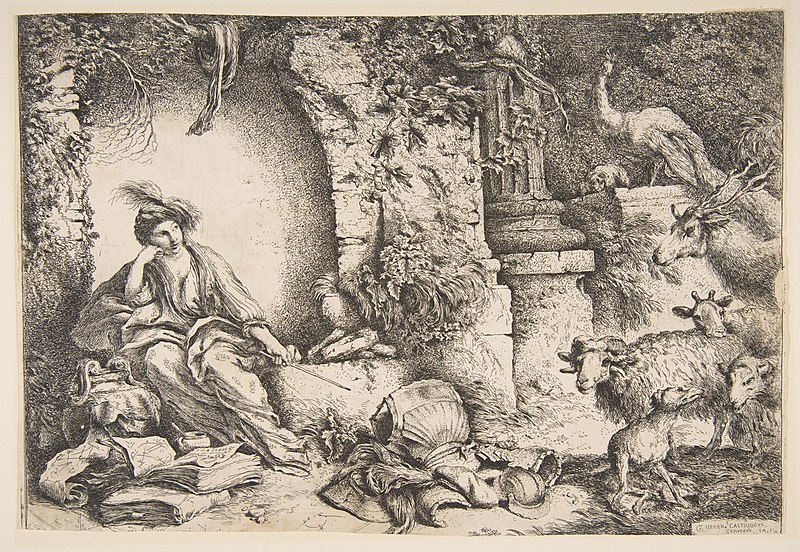
Circe’s Symbols, Animals, and Plants
Circe’s association with magic and transformation is often symbolized through her wand or staff, an instrument of her power. Animals, especially those she transformed such as lions, wolves, and swine, are also emblematic of her dominion and abilities.
Her island, Aeaea, was abundant with a plethora of herbs and plants, many of which she used for her potions. Among these, the moly plant, which Hermes gave to Odysseus to resist her enchantment, stands out as particularly significant.

Circe’s Roles and Responsibilities
Circe’s primary role in Greek mythology is that of a sorceress, a wielder of magic and mistress of transformation. Her island, Aeaea, served as both her sanctuary and her domain, where she exercised her powers freely, away from the prying eyes of other gods and mortals.
Beyond her magical abilities, Circe played the role of a guide, especially to Odysseus. She provided him with invaluable advice and assistance, helping him navigate the challenges that lay ahead in his journey. Her knowledge of the seas, monsters, and other perils made her an indispensable ally to the Ithacan hero.
Furthermore, Circe’s interactions with other figures in mythology highlight her role as a mediator between the mortal and divine realms. Her ability to communicate with the dead, transform humans, and liaise with gods like Hermes showcases her unique position in the pantheon of Greek deities.
Myths about Circe
Circe, with her enchanting beauty and unparalleled knowledge of magic, has been a central figure in numerous myths, with her tales weaving a complex tapestry of intrigue, passion, and transformation. While her encounter with Odysseus in the “Odyssey” remains the most iconic, there are other tales that shed light on her character and her interactions with mortals and gods alike.
Circe and Odysseus
Odysseus’s encounter with Circe is a defining moment in his long and perilous journey home from Troy. Upon arriving at Aeaea, his crew, lured by Circe’s singing, ventured into her abode only to be transformed into pigs. This transformation wasn’t just physical; it was symbolic of the men’s base desires and lack of discipline. Odysseus, with the aid of Hermes and the protective moly plant, confronts Circe and manages to reverse the spell. Their initial confrontation, filled with tension and uncertainty, soon gives way to a mutual respect.
Circe, impressed by Odysseus’s wit and resilience, not only releases his men but also takes him as her lover. They spend a year on her island, a period of respite and reflection for the weary hero. Circe becomes his confidante, offering him guidance for the trials ahead, including the treacherous journey to the Underworld.
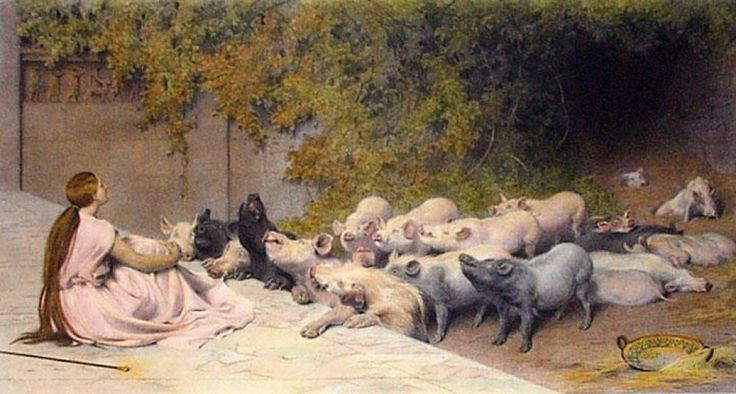
Circe’s Role in the Nekyia
The Nekyia, or the descent into the Underworld, is one of the most haunting and profound segments of the “Odyssey.” Circe plays a pivotal role in this, guiding Odysseus on how to communicate with the spirits of the dead. She provides him with detailed rituals, from the digging of a trench to the sacrifices he must offer.
It’s under her guidance that Odysseus meets the spirit of the blind prophet Tiresias, who offers prophecies about his journey home. This descent into the realm of Hades, the god of the underworld, filled with encounters with lost comrades and the shades of heroes past, is made possible by Circe’s knowledge and expertise.
Circe and Scylla
Another lesser-known but intriguing myth involves Circe and the transformation of the nymph Scylla into a monstrous sea creature. Scylla was once a beautiful nymph loved by the sea god Glaucus. However, Glaucus, The Tragic Sea God had previously spurned Circe’s advances.
In a fit of jealousy, Circe poisoned the waters where Scylla bathed, turning her into a twelve-legged monster with six heads, each having three rows of sharp teeth. This transformation of Scylla, The Sea Monster of Ancient Lore, much like the transformation of Odysseus’s men, showcases Circe’s powers as well as the consequences of invoking her wrath.
Circe in Ancient Greek Religion
While Circe might not have been one of the primary deities worshiped in ancient Greece, her influence and tales permeated the culture. Her island, Aeaea, though mythical, was a symbol of the distant and unknown, a place where the boundaries between the mortal and divine blurred.
There aren’t any known temples or sites dedicated exclusively to Circe in ancient Greece. However, her legend was so potent that many believed Aeaea to be a real place. Various locations in the Mediterranean were proposed as the possible site of this enchanted island, though none were confirmed.
Representations of Circe in Art
Circe’s enigmatic persona made her a popular subject in ancient art. She’s often depicted in the act of transformation, with her wand or staff in hand, surrounded by animals. One of the most iconic representations is on ancient Greek vases, where her encounter with Odysseus is vividly portrayed. In these artworks, the tension and intrigue, as well as the allure of their meeting come alive, capturing the essence of their complex relationship.
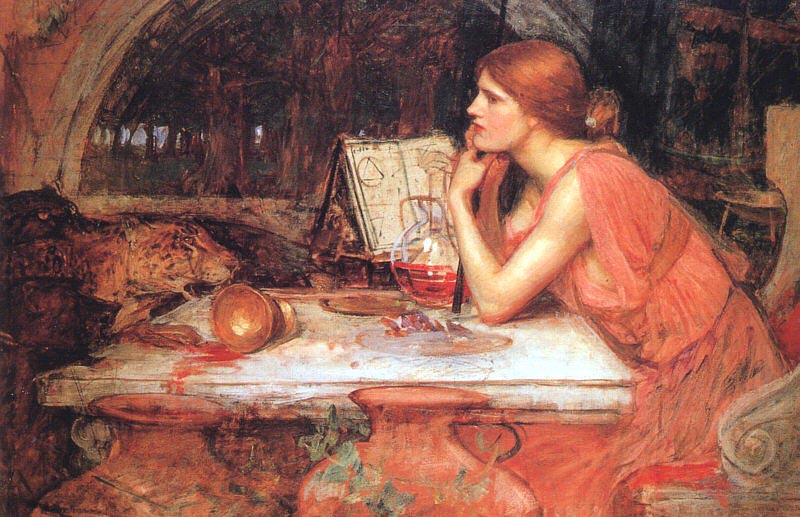
Mentions in Ancient Texts
Homer’s “Odyssey” remains the primary source of information about Circe, offering a detailed account of her encounter with Odysseus. In this epic, she’s portrayed as both a formidable sorceress and a benevolent guide, showcasing her multifaceted nature.
“Then Circe took me by the hand and bade me be seated away from the others, while she reclined by my side and asked me all about our adventures.” – Odyssey, Book X
Apart from the “Odyssey,” Circe is mentioned in various other texts, including Hesiod’s “Theogony” and the works of early Roman poets, who were captivated by her tales and the lessons they imparted.
Frequently Asked Questions
Circe, the enchantress of Aeaea, transformed Odysseus’s crew into swine when they first arrived on her island.
Circe resided on the mythical island of Aeaea, a place filled with magic and wonder.
Circe was a sorceress, a nymph with divine powers, particularly skilled in the arts of transformation and magic.
With the help of the god Hermes, Odysseus used the moly plant to resist Circe’s enchantment.
Yes, they had a son named Telegonus, who later played a tragic role in Odysseus’s life.
In Roman mythology, Circe retains her name and is known for similar tales of enchantment and transformation.
Featured Image Credit: kladcat, Public domain, via Wikimedia Commons

